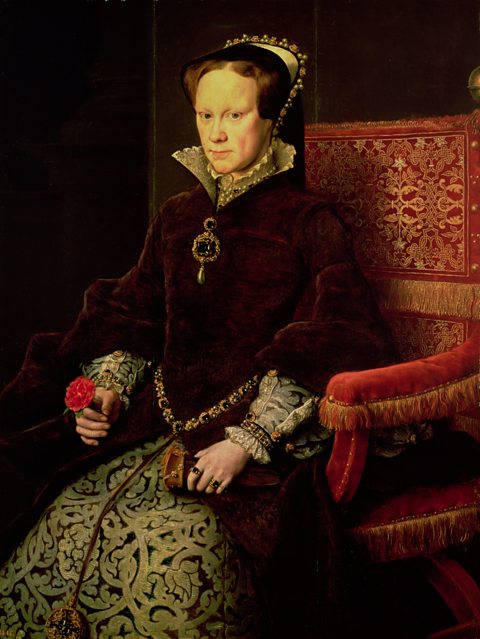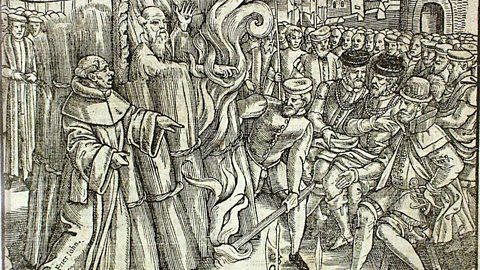The impact of religious change in the 16th century
Religious change was a significant cause of crime in the 16th and 17th centuries. Failure to follow and swear allegiance to the changes each monarch made to religion was a crime. Many people were punished for heresy To disagree with, or refuse to follow the religious views of the monarch or the state. in this period.
People who opposed the religious changes sometimes refused to follow the new practices, spoke out publicly against the changes, or organised rebellions or conspiracies against the monarchy. These actions were crimes in Tudor times.
The reformation therefore led to the monarchy, Government and Parliament becoming more involved in religious matters. This meant that often someone committing the crime of heresy would also be committing treason Betraying your country. For example, plotting against the monarchy. .
Causes of heresy and treason under Henry VIII
The 16th century saw the start of the Protestant Reformation in Europe. These Protestant ideas began to spread to England and Wales in the 1520s and started to influence many people. However, it was Henry VIII’s divorce crisis from 1529 that was the catalyst for the start of the reformation in England and Wales.
Thomas Cromwell used Parliament to pass a series of laws that separated the Church in England from the Catholic Church, and made Henry VIII the head of the Church in England and Wales instead of the Pope in Rome. The Bible was translated into English in 1539, however little else changed. Church services and prayers remained in Latin and priests were not allowed to marry.
| The Laws of Henry VIII | Outcomes |
| Act of Supremacy 1534 | This law made Henry VIII head of the Church in England and Wales. Those who refused to accept Henry's authority over the Church were punished. Sir Thomas More was executed as he refused to swear the Oath of Supremacy. |
| Act of Succession 1534 | The children of Henry’s new wife, Anne Boleyn, were given precedence in the succession over his daughter Mary. A Treason Act in the same year made opposing this law or the Act of Supremacy a crime punishable by death. |
| Dissolution of the monasteries 1536-40 | The monasteries were closed across the country. |
| Act of Six Articles | Reaffirmed the Catholic faith. Protestants who denied the Catholic faith could be burned at the stake. |
| The Laws of Henry VIII | Act of Supremacy 1534 |
|---|---|
| Outcomes | This law made Henry VIII head of the Church in England and Wales. Those who refused to accept Henry's authority over the Church were punished. Sir Thomas More was executed as he refused to swear the Oath of Supremacy. |
| The Laws of Henry VIII | Act of Succession 1534 |
|---|---|
| Outcomes | The children of Henry’s new wife, Anne Boleyn, were given precedence in the succession over his daughter Mary. A Treason Act in the same year made opposing this law or the Act of Supremacy a crime punishable by death. |
| The Laws of Henry VIII | Dissolution of the monasteries 1536-40 |
|---|---|
| Outcomes | The monasteries were closed across the country. |
| The Laws of Henry VIII | Act of Six Articles |
|---|---|
| Outcomes | Reaffirmed the Catholic faith. Protestants who denied the Catholic faith could be burned at the stake. |
Heresy and treason therefore became more common crimes under Henry VIII in the 1530s and 1540s as anyone who did not follow and support these changes was committing a crime. Many people were burned for heresy, or executed for treason during Henry’s reign.
In 1536, 30,000 people protested against Henry’s changes in a Pilgrimage of Grace and took control of York, Hull, Pontefract and Doncaster. 178 protestors were executed including the leader, Robert Aske.
Causes of religious crime under Edward VI and Mary I (Mary Tudor)
After Henry VIII’s death in 1547 his young son, Edward VI made the church Protestant.
- An English Book of Common Prayer was introduced.
- The Latin Mass was abolished and church services were changed to be Protestant.
- Priests could marry.
- Catholic shrines, images and decorations were removed.
Catholic Bishops who refused to follow Edward’s changes were imprisoned for heresy. But there were only two executions for heresy in this reign.

The Catholic Mary Tudor came to the throne in 1553 after a brief attempt by the Protestants to have Lady Jane Grey crowned Queen. She quickly reversed all of Edward’s religious changes. Mary restored the rule of the Pope and brought Catholic practices back to the Church.
- Mary brought back the Latin Mass.
- Churches were made Catholic again - shrines, stained glass windows and Catholic alters were all brought back.
- Latin Bibles were used again.
- Priests were not allowed to have wives.
People who refused to accept Mary’s changes were guilty of heresy. Leading Protestant bishops were tried for heresy by Mary.

In 1554, Thomas Wyatt and 90 other Protestant rebels were executed for treason after their plot to overthrow Mary and replace her with Elizabeth, a Protestant, failed.
Causes of religious crime under Elizabeth I
Elizabeth I came to the throne in 1558. Her religious 'settlement' was a return to moderate Protestantism.
- Elizabeth became Head of the Church, but called herself Supreme Governor rather than Head.
- Church services, prayer books and the Bible were in English. However, a Latin prayer book was also printed.
- Some Catholic Church decorations and vestments were allowed.
- The new prayer book made an attempt to compromise Catholic and Protestant views on the Communion.
Many Catholics were deeply unhappy about Elizabeth’s religious settlement. Cardinal William Allen refused to take the Oath of Supremacy and fled to Rome. Throughout Elizabeth’s reign, Catholic priests were trained abroad and returned to England to try to convert people.
Some Catholics engaged in plots against Elizabeth with the aim of replacing her with her Catholic cousin, Mary Queen of Scots. Many Catholics continued to practice in the Catholic way. Catholic preachers who continued to preach were committing a crime and were punished if caught.
Elizabeth claimed that she did not persecute people for heresy, and only four Catholics were put to death as heretics. However, it is estimated that 250 Catholics were executed for the crime of treason during Elizabeth’s reign. Richard Gwyn was put to death in Wrexham in 1584 and William Davies, a Catholic priest, was executed in Beaumaris in 1593.